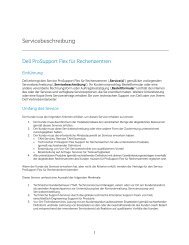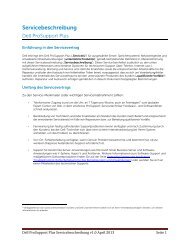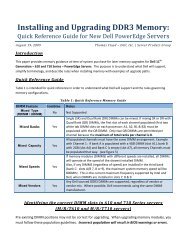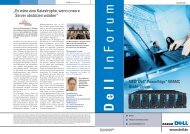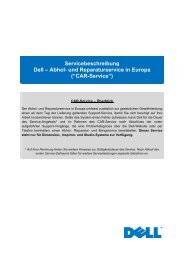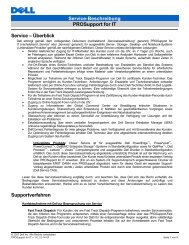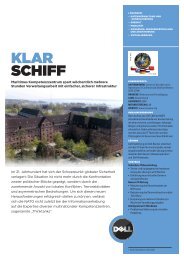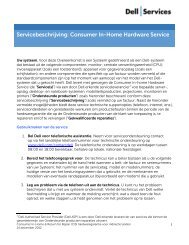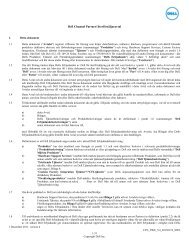Common Criteria for Choosing a Storage Array - Dell
Common Criteria for Choosing a Storage Array - Dell
Common Criteria for Choosing a Storage Array - Dell
You also want an ePaper? Increase the reach of your titles
YUMPU automatically turns print PDFs into web optimized ePapers that Google loves.
White Paper<br />
Abstract<br />
Solution Guide – <strong>Choosing</strong> <strong>Storage</strong> <strong>for</strong> <strong>Dell</strong> Database Solutions<br />
with <strong>Dell</strong> PowerVault and <strong>Dell</strong>/EMC <strong>Storage</strong><br />
This white paper provides a guide <strong>for</strong> choosing an appropriate storage architecture <strong>for</strong> <strong>Dell</strong> Database<br />
Solutions deployed on <strong>Dell</strong> PowerEdge servers with <strong>Dell</strong> PowerVault and <strong>Dell</strong>/EMC storage. Using the<br />
knowledge gained through joint development, testing and support with Microsoft and Oracle, this white<br />
paper documents “best practices” that can help you select a storage solution to meet your capacity,<br />
per<strong>for</strong>mance and availability needs.<br />
October 2007<br />
<strong>Choosing</strong> <strong>Storage</strong> <strong>for</strong> <strong>Dell</strong> Database Solutions 1
THIS WHITE PAPER IS FOR INFORMATIONAL PURPOSES ONLY, AND MAY CONTAIN<br />
TYPOGRAPHICAL ERRORS AND TECHNICAL INACCURACIES. THE CONTENT IS PROVIDED<br />
AS IS, WITHOUT EXPRESS OR IMPLIED<br />
WARRANTIES OF ANY KIND.<br />
.<br />
© 2007 <strong>Dell</strong> Inc. All rights reserved.<br />
Reproduction in any manner whatsoever without the written permission of <strong>Dell</strong> Inc. is strictly <strong>for</strong>bidden.<br />
Trademarks used in this text: <strong>Dell</strong>, the DELL logo, PowerEdge and PowerVault are trademarks of <strong>Dell</strong> Inc.;<br />
Intel and Xeon are registered trademarks of Intel Corporation; EMC, Navisphere, and PowerPath are<br />
registered trademarks of EMC Corporation; Microsoft, Windows, and Windows Server are registered<br />
trademarks of Microsoft Corporation.<br />
Other trademarks and trade names may be used in this document to refer to either the entities claiming the<br />
marks and names or their products. <strong>Dell</strong> Inc. disclaims any proprietary interest in trademarks and trade<br />
names other than its own.<br />
October 2007 Rev. A01<br />
<strong>Choosing</strong> <strong>Storage</strong> <strong>for</strong> <strong>Dell</strong> Database Solutions 2
Table of Contents<br />
INTRODUCTION ........................................................................................................................................ 4<br />
DELL DATABASE SOLUTIONS FOR ORACLE 10G AND MICROSOFT SQL SERVER 2005 ............................... 4<br />
OVERVIEW OF THIS WHITE PAPER.............................................................................................................. 4<br />
OVERVIEW OF DELL STORAGE SYSTEMS ....................................................................................... 5<br />
DIRECT-ATTACHED SERIAL-ATTACHED SCSI (SAS)................................................................................. 5<br />
PowerVault MD3000 Direct-Attached <strong>Storage</strong> <strong>Array</strong>......................................................................... 5<br />
MD3000 Capacity................................................................................................................................. 5<br />
MD3000 Availability ............................................................................................................................ 6<br />
INTERNET SCSI (ISCSI) STORAGE NETWORKING ...................................................................................... 7<br />
PowerVault MD3000i iSCSI <strong>Storage</strong> <strong>Array</strong>........................................................................................ 7<br />
MD3000i Capacity and Availability..................................................................................................... 8<br />
FIBRE CHANNEL STORAGE NETWORKING .................................................................................................. 8<br />
<strong>Dell</strong>/EMC CX3 Series FC <strong>Storage</strong> <strong>Array</strong>s .......................................................................................... 8<br />
<strong>Dell</strong>/EMC CX3 Series Capacity ........................................................................................................... 9<br />
<strong>Dell</strong>/EMC CX3 Series Availability....................................................................................................... 9<br />
COMMON CRITERIA FOR CHOOSING A STORAGE ARRAY...................................................... 11<br />
ARCHITECTURAL COMPLEXITY ................................................................................................................ 11<br />
COST ........................................................................................................................................................ 11<br />
SCALABILITY............................................................................................................................................ 12<br />
OVERVIEW OF DATABASE PERFORMANCE WITH DELL STORAGE ARRAYS.................... 13<br />
SELECTING A STORAGE ARRAY FOR A DELL DATABASE SOLUTION ................................. 15<br />
CONCLUSIONS......................................................................................................................................... 17<br />
TABLES AND FIGURES INDEX ............................................................................................................ 18<br />
REFERENCES ........................................................................................................................................... 18<br />
<strong>Choosing</strong> <strong>Storage</strong> <strong>for</strong> <strong>Dell</strong> Database Solutions 3
Introduction<br />
<strong>Dell</strong> PowerEdge servers, <strong>Dell</strong> PowerVault storage systems and <strong>Dell</strong>/EMC storage systems are ideal<br />
choices to deploy highly reliable and sustainable Oracle® Database 10g and Microsoft® SQL Server<br />
2005 solutions. This white paper is intended to help IT professionals design and configure Oracle 10g and<br />
SQL Server 2005 database solutions using <strong>Dell</strong> servers and storage that apply “best practices” derived from<br />
laboratory and real-world experiences. This white paper provides criteria and guidance to assist in the<br />
selection of the appropriate storage system <strong>for</strong> your <strong>Dell</strong> Database Solution.<br />
<strong>Dell</strong> Database Solutions <strong>for</strong> Oracle 10g and Microsoft SQL Server 2005<br />
<strong>Dell</strong> Database Solutions <strong>for</strong> Oracle 10g and Microsoft SQL Server 2005 are designed to simplify<br />
operations, improve utilization and cost-effectively scale as your needs grow over time. In addition to<br />
providing price/per<strong>for</strong>mance leading server and storage hardware, <strong>Dell</strong> Solutions <strong>for</strong> Oracle 10g and SQL<br />
Server 2005 include:<br />
<strong>Dell</strong> Tested and Validated Configurations – in-depth testing of Oracle 10g and SQL Server 2005<br />
configurations with <strong>Dell</strong> servers and storage; documentation and tools that help simplify deployment<br />
Integrated Solution Management – standards-based management of <strong>Dell</strong> Database Solutions that lower<br />
operational costs through integrated hardware and software deployment, monitoring and update<br />
Database Software Licensing - multiple licensing options that can simplify customer purchase<br />
<strong>Dell</strong> Enterprise Support and Professional Services <strong>for</strong> <strong>Dell</strong> Database Solutions – offerings <strong>for</strong> the<br />
planning, deployment and maintenance of <strong>Dell</strong> Solutions <strong>for</strong> Oracle 10g and SQL Server 2005<br />
<strong>Dell</strong> PowerEdge servers and <strong>Dell</strong> <strong>Storage</strong> help to minimize operating costs with price/per<strong>for</strong>mance<br />
leadership - <strong>Dell</strong> currently holds price/per<strong>for</strong>mance leadership <strong>for</strong> TPC-E and seven of the top ten TPC-C<br />
price/per<strong>for</strong>mance leadership positions with SQL 1 .<br />
For more in<strong>for</strong>mation about <strong>Dell</strong> Solutions <strong>for</strong> SQL Server 2005, see www.dell.com/sql.<br />
For more in<strong>for</strong>mation about <strong>Dell</strong> Solutions <strong>for</strong> Oracle 10g Database, see www.dell.com/oracle.<br />
Overview of this White Paper<br />
When deploying a database solution, IT professionals are faced with a range of choices <strong>for</strong> storing their<br />
data, each choice providing varying capacities, per<strong>for</strong>mance and availability features. This white paper is<br />
intended to guide the reader with a set of criteria and recommendations that can be used to identify the<br />
appropriate <strong>Dell</strong> <strong>Storage</strong> system <strong>for</strong> your <strong>Dell</strong> Database Solution.<br />
1<br />
Source: TPC-E by Price/Per<strong>for</strong>mance Version 1 and TPC-C by Price/Per<strong>for</strong>mance Version 5 Results as of<br />
October 2007. See www.tpc.org <strong>for</strong> current results<br />
<strong>Choosing</strong> <strong>Storage</strong> <strong>for</strong> <strong>Dell</strong> Database Solutions 4
Overview of <strong>Dell</strong> <strong>Storage</strong> Systems<br />
<strong>Dell</strong> offers several different storage options that can be deployed into database solutions. Modern storage<br />
systems generally employ one or more of the following technologies: Serial-Attached SCSI (SAS), Internet<br />
SCSI (iSCSI), and Fibre Channel (FC). Each of these technologies has a shared heritage, as they have each<br />
evolved to overcome the limitations and constraints of the traditional parallel SCSI infrastructure. All three<br />
technologies were designed with advanced storage array features, such as multi-path I/O and multi-initiator<br />
environments (e.g. clusters), in mind.<br />
This section provides an overview of each of these technologies and the application of the technologies in<br />
current <strong>Dell</strong> storage arrays that help make them well suited <strong>for</strong> use with database solutions. For database<br />
solutions that feature a single, non-clustered, database server, any of the storage arrays discussed in this<br />
paper may be connected directly to the host server. To better support the deployment of clustered database<br />
servers using Microsoft Cluster Service (MSCS) with SQL Server 2005 or Oracle Real Application<br />
Clusters with Oracle Database 10g, these storage arrays also provide storage-based RAID engines which<br />
provide write cache mirroring and battery backup systems <strong>for</strong> the cache memory. These features allow<br />
storage array write caching to be enabled, even in multi-initiator environments, a function generally not<br />
possible with server-based RAID controllers.<br />
Direct-Attached Serial-Attached SCSI (SAS)<br />
Direct-attached storage refers to a topology in which a storage system and server(s) are connected to one<br />
another without any switches or storage network components. This topology can be employed with most<br />
existing storage device interconnect technologies, including Serial-Attached SCSI (SAS), Fibre Channel<br />
(FC), and Internet SCSI (iSCSI). Direct-attached storage topologies not only offer a simple and costeffective<br />
way to increase the storage capacity of a particular host, but can also provide storage-based RAID<br />
and the ability to connect multiple hosts – features that were once only available with more-complex<br />
networked storage topologies, including network attached storage (NAS) and storage area network (SAN).<br />
PowerVault MD3000 Direct-Attached <strong>Storage</strong> <strong>Array</strong><br />
The <strong>Dell</strong> PowerVault MD3000 is a high-per<strong>for</strong>mance storage array designed to be connected via a directattached<br />
topology to servers that are equipped with SAS host bus adapters, such as the <strong>Dell</strong> SAS/5E. Figure<br />
1 provides an example of connecting a single <strong>Dell</strong> PowerEdge server to the MD3000. The MD3000<br />
features dual-ported SAS hard-disk drives and is connected to the host servers using SAS wide-link (x4)<br />
cables. In a direct-attached topology, the number of servers which can connect to the storage is determined<br />
by the number of host ports available on each RAID controller, and whether hosts are configured to use<br />
redundant connections.<br />
MD3000 Capacity<br />
Each MD3000 unit supports up to 15 SAS drives and can be expanded by daisy-chaining up to two<br />
MD1000 storage arrays <strong>for</strong> a total of 45 SAS drives. The drives provide capacities of up to 300 gigabytes<br />
and either 10,000 RPM or 15,000 RPM speeds. Each of the four SAS ports available on the MD3000<br />
operate at a peak of 3.0 gigabits per second (Gbps) <strong>for</strong> an aggregate peak throughput of 12 Gbps.<br />
<strong>Choosing</strong> <strong>Storage</strong> <strong>for</strong> <strong>Dell</strong> Database Solutions 5
Figure 1 - Single Server Directly Attached to a PowerVault MD3000 <strong>Storage</strong> <strong>Array</strong><br />
MD3000 Availability<br />
Although the MD3000 can be operated with a single RAID controller, <strong>Dell</strong> best practices recommend that<br />
redundant controllers be used to increase the resiliency of the solution and to maximize the availability of<br />
the data stored by a database solution. Each RAID controller on the MD3000 features two host ports.<br />
There<strong>for</strong>e, it is possible to connect up to four hosts, each with a single data path – however, this introduces<br />
single points of failure in the storage subsystem, and is not optimal <strong>for</strong> database solutions. The <strong>Dell</strong><br />
recommended configuration <strong>for</strong> database solutions features an MD3000 with redundant RAID controllers<br />
and provides <strong>for</strong> the connection of two hosts, each with redundant data paths (e.g. one connection from<br />
each server to each RAID controller). This configuration shown in Figure 2 greatly helps reduce the<br />
possibility that a single point of failure might cause any connected server to lose access to the storage<br />
system. I/O paths into RAID controllers are managed by a multi-path driver, which re-routes I/O request<br />
from the hosts to the other controller when a failure of one of the I/O paths occurs. To further enhance<br />
availability, each RAID controller includes a backup battery that can hold cached data in the controller’s<br />
cache memory <strong>for</strong> up to 72 hours without external power. Redundancy is provided <strong>for</strong> cached writes as<br />
they are mirrored between controllers.<br />
Additional availability and integrity features of the MD3000 include hot- pluggable, redundant power<br />
supplies, cooling modules and disk drives; active disk scrubbing and non-disruptive firmware upgrades. In<br />
addition, the MD3000 offers two optional Premium Features: Snapshot Virtual Disks and Virtual Disk<br />
Copy. Snapshot Virtual Disk creates point-in-time snapshots of a data volume. Using a copy-on-first-write<br />
technique, data on source virtual disks can be updated without changing the contents of the point-in-time<br />
snapshot. Snapshots are often used as part of a backup system, reducing the time during which a database<br />
must be in a quiescent state. Virtual Disk Copy produces a full block-by-block copy of a source virtual<br />
disk, which can be utilized in the same manner as “clones” or “business continuity volumes”, such as <strong>for</strong><br />
disk-based backups, recovery to a state preserved via a snapshot, or migration of data to a larger volume.<br />
For more in<strong>for</strong>mation about these features, refer to the <strong>Dell</strong> PowerVault Modular Disk <strong>Storage</strong> Manager<br />
User’s Guide, which is available from http://support.dell.com/.<br />
<strong>Choosing</strong> <strong>Storage</strong> <strong>for</strong> <strong>Dell</strong> Database Solutions 6
Figure 2 - Cluster Directly Attached to a PowerVault MD3000 <strong>Storage</strong> <strong>Array</strong><br />
Internet SCSI (iSCSI) <strong>Storage</strong> Networking<br />
Internet SCSI (iSCSI) is an industry standard that encapsulates SCSI block I/O commands and data <strong>for</strong><br />
transmission via a TCP/IP network. The iSCSI protocol can be used to establish and manage connections<br />
between storage devices and hosts using standard Ethernet networks. iSCSI storage devices may be<br />
directly-attached, or can be deployed as networked solutions, which are often called IP SANs. Each host in<br />
an iSCSI solution is configured with iSCSI initiators that connect to iSCSI targets on the storage device.<br />
These iSCSI ports are interconnected by means of standard Gigabit Ethernet hardware. In order to<br />
communicate with an iSCSI storage device, each attached host must employ an iSCSI initiator. Software<br />
iSCSI initiators are available <strong>for</strong> Microsoft® Windows Server® and Linux operating systems, and allow<br />
common GbE adapters to be used in lieu of dedicated storage host bus adapters (HBAs). GbE adapters that<br />
feature a TCP/IP Offload Engine (TOE), can also be used, but have been shown to have a minimal impact<br />
to the overall per<strong>for</strong>mance of the storage subsystem - typically less than a 5% improvement in iSCSI<br />
throughput.<br />
PowerVault MD3000i iSCSI <strong>Storage</strong> <strong>Array</strong><br />
The <strong>Dell</strong> PowerVault MD3000i is designed as a flexible IP SAN storage array that employs the iSCSI<br />
protocol <strong>for</strong> communication with host servers. Like the MD3000, the MD3000i features dual-ported SAS<br />
hard-disk drives, and is offered with a single controller which provides two 1 Gb/s Ethernet (GbE) ports.<br />
<strong>Dell</strong> best practices <strong>for</strong> database solutions recommends that each MD3000i storage array use dual RAID<br />
controllers <strong>for</strong> redundancy, with each controller featuring two GbE ports <strong>for</strong> a total of four 1Gb Ethernet<br />
ports <strong>for</strong> server host connections. In this configuration, the MD3000i can be directly-attached to two hosts,<br />
and each host has an available data path to each RAID controller to provide redundancy in the event of a<br />
component failure. The MD3000i and the accessing servers can also be interconnected via GbE switches.<br />
In this configuration, shown in Figure 3, the MD3000i may provide storage <strong>for</strong> up to 16 separate or<br />
clustered hosts.<br />
<strong>Choosing</strong> <strong>Storage</strong> <strong>for</strong> <strong>Dell</strong> Database Solutions 7
MD3000i Capacity and Availability<br />
Since the PowerVault MD3000i and MD3000 share a common RAID controller architecture, the MD3000i<br />
provides the same maximum storage capacity of 45 drives and implements a common availability feature<br />
set, including support <strong>for</strong> the Snapshot Virtual Disks and Virtual Disk Copy Premium Features.<br />
Figure 3 - <strong>Dell</strong> PowerVault MD3000i IP SAN Architectural Overview<br />
Fibre Channel <strong>Storage</strong> Networking<br />
Fibre Channel (FC) is a multi-gigabit speed network technology that is primarily used <strong>for</strong> storage<br />
networking, providing a high-per<strong>for</strong>mance interconnect <strong>for</strong> servers and storage systems that can operate of<br />
long distances with low latency and low transmission error rates. FC networks support various industry<br />
standard protocols including SCSI and can be implemented with direct connect and switched fabric<br />
topologies. Supporting up to hundreds of end nodes with operating speeds of up to 4 Gbps, and inter-node<br />
distances of up to 2 kilometers 2 , FC networks are well suited <strong>for</strong> implementing large-scale <strong>Storage</strong> Area<br />
Networks (SAN) providing high per<strong>for</strong>mance and high availability.<br />
<strong>Dell</strong>/EMC CX3 Series FC <strong>Storage</strong> <strong>Array</strong>s<br />
The <strong>Dell</strong>/EMC CX3-series storage arrays are designed as scalable and flexible Fibre Channel (FC) storage<br />
arrays, featuring dual-ported 4 Gb/s FC hard-disk drives and 4 Gb/s FC host connections. The series<br />
includes the CX3-10c, CX3-20, CX3-40, and CX3-80 <strong>Storage</strong> arrays. The differences between these arrays<br />
are highlighted in Table 1, and include the following: number and speed of the CPU(s) in the storage<br />
processors (SPs), the number of host connections (front-end ports), the number of hard-disk loop<br />
connections (back-end ports), the size of the SP read/write cache, and the number of supported hard-disk<br />
drives.<br />
2<br />
The maximum distance between components is dependent on the speed and on type of optical ports used.<br />
Refer to the documentation <strong>for</strong> the storage array, FC HBA, and FC switch in your solution <strong>for</strong> more details.<br />
<strong>Choosing</strong> <strong>Storage</strong> <strong>for</strong> <strong>Dell</strong> Database Solutions 8
<strong>Dell</strong>/EMC CX3 Series Capacity<br />
Depending on which model is selected, the CX3-series supports anywhere from 60 to 480 hard disks<br />
attached to the same array, and when deployed in a SAN up to four arrays can be utilized by the same host<br />
server. A single CX3-80 array can support over 350 TB of raw disk storage. The specifics <strong>for</strong> each model<br />
in the CX3-series are detailed in Table 1. The front-end ports listed in the table are used either <strong>for</strong> directattached<br />
hosts or to connect the CX3-series array to an FC SAN. In either case, redundant connections are<br />
recommended to provide multi-path I/O and to ensure continued data availability <strong>for</strong> database servers in the<br />
event of many types of failures. The CX3 series architecture is shown in Figure 4.<br />
Features CX3-10C<br />
CX3-20<br />
CX3-20c<br />
CX3-20f<br />
CX3-40<br />
CX3-40c<br />
CX3-40f CX3-80<br />
No. of CPUs per SP 1 1 1 2 2 2<br />
CPU Frequency 2.8 GHz 2.8 GHz 2.8 GHz 2.8 GHz 2.8 GHz 3.6 GHz<br />
<strong>Array</strong> Cache<br />
(2 SPs)<br />
2 GB 4 GB 4 GB 8 GB 8 GB 16 GB<br />
Maximum Drives per<br />
<strong>Array</strong> 60 120 120 240 240 480<br />
Maximum Additional<br />
DAEs per <strong>Array</strong> 3 7 7 15 15 31<br />
Maximum No. of<br />
redundantly-attached<br />
hosts<br />
4 Gbps FC front-end<br />
ports per array<br />
(2 SPs)<br />
4 Gbps back-end loops<br />
(2 SPs provide<br />
redundancy)<br />
64 128 128 128 128 256<br />
4 4 12 4 8 8<br />
1 1 1 2 4 4<br />
Table 1 – <strong>Dell</strong>/EMC CX3 Series Comparison<br />
<strong>Dell</strong>/EMC CX3 Series Availability<br />
The <strong>Dell</strong>/EMC CX3 storage systems are made up of the following modular components: storage processor<br />
enclosure (SPE), disk array enclosure (DAE) and dual standby power supplies (SPS). The SPE contains a<br />
pair of storage processors (SP) to provide redundancy. Each DAE houses up to 15 FC or SATA disks. For<br />
primary storage <strong>for</strong> database solutions, <strong>Dell</strong> recommends the use of FC disks. A <strong>Dell</strong>/EMC CX3-series<br />
storage array requires at least one DAE, which contains the operating software <strong>for</strong> the storage array.<br />
Additional DAEs may be added to increase the capacity of the storage system. The SPS enables proper<br />
shutdown of the storage system during power failure by powering the SPE and first DAE long enough to<br />
allow the SPs to safely move the data currently in the write cache to a vault area on the first DAE. When<br />
configured with two SPs, the CX3-series also provides a mirrored write cache.<br />
All <strong>Dell</strong>/EMC CX3 series arrays also support optional features, including SnapView snapshots and clones,<br />
MirrorView/Asynchronous, MirrorView/Synchronous, and SANCopy. SnapView snapshots and clones<br />
offer functions similar to the Virtual Snapshot Disk and Virtual Disk Copy Premium Features on the<br />
PowerVault MD3000 and MD3000i. MirrorView allows mirroring of a LUN from one CX3-series array to<br />
another array, and SANCopy allows copying or migrating LUNs between separate arrays.<br />
<strong>Choosing</strong> <strong>Storage</strong> <strong>for</strong> <strong>Dell</strong> Database Solutions 9
Figure 4 - <strong>Dell</strong>/EMC CX3 Series Architectural Overview<br />
<strong>Choosing</strong> <strong>Storage</strong> <strong>for</strong> <strong>Dell</strong> Database Solutions 10
<strong>Common</strong> <strong>Criteria</strong> <strong>for</strong> <strong>Choosing</strong> a <strong>Storage</strong> <strong>Array</strong><br />
There are several factors to consider when selecting a storage system <strong>for</strong> a database solution. Since<br />
database solutions fill a wide range of needs and are deployed into vastly different customer environments,<br />
the key factors that influence this decision vary from case to case. It is also important that the storage<br />
system is considered in the context of the entire database solution, including not only the storage hardware,<br />
but also servers, interconnect components, and software. The <strong>Dell</strong> storage systems discussed above will be<br />
compared in terms of the following criteria: architectural complexity, storage system cost, and scalability.<br />
Additionally, certain per<strong>for</strong>mance criteria <strong>for</strong> these storage systems will be discussed. Refer to the<br />
“Overview of Database Per<strong>for</strong>mance with <strong>Dell</strong> <strong>Storage</strong> <strong>Array</strong>s” section <strong>for</strong> this analysis.<br />
Architectural Complexity<br />
The MD3000 and MD3000i share a common architecture, except <strong>for</strong> the ports used to connect host servers.<br />
There<strong>for</strong>e, it is appropriate to compare these systems collectively to the <strong>Dell</strong>/EMC storage arrays. The<br />
RAID controllers in the PowerVault MD-series storage systems serve as the “brains” of the storage array.<br />
These controllers per<strong>for</strong>m the RAID calculations, control the I/O movement, communicate with the<br />
management client, store the firmware, and protect data until it can be written safely to the hard disk drives.<br />
MD-series storage arrays offer redundant RAID controllers with internal cache backup batteries, power<br />
supplies, cooling fans, and hard disk drives in a single three rack unit (3U) enclosure. <strong>Dell</strong> PowerVault<br />
MD1000 storage systems, which provide more disk capacity, each require an additional 3U. Conversely,<br />
the <strong>Dell</strong>/EMC CX3-series storage systems feature separate modules <strong>for</strong> storage processors, disk drives and<br />
standby power supplies. A CX3-series storage system requires at least 5U <strong>for</strong> the first 15 hard-disk drives.<br />
Additional DAEs each require 3U. The integrated design of the <strong>Dell</strong> PowerVault MD-series is easier to<br />
understand and simpler to deploy.<br />
In addition, different storage protocols and topologies impose different physical distance limitations among<br />
these <strong>Dell</strong> storage systems. The MD3000, by nature of employing a direct-attached topology, requires that<br />
the servers are physically close to the storage system, and is determined by the maximum allowable length<br />
of a SAS x4 cable, which is approximately four meters. <strong>Dell</strong>/EMC Fibre Channel SAN and MD3000 IP<br />
SAN allow greater distance between the storage and server, allowing more flexible deployment within a<br />
datacenter. Distance-extension solutions <strong>for</strong> Fibre Channel and iSCSI may be used to enable replication of<br />
data over considerable distances between sites as part of a business continuity or disaster recovery plan.<br />
Cost<br />
The components required by a Fibre channel storage array such as the <strong>Dell</strong>/EMC CX3-series, including the<br />
server HBA, optical cabling, switches and other infrastructure components tend to be more expensive than<br />
the equivalent components required <strong>for</strong> other storage solutions. For example, iSCSI can significantly lower<br />
the cost of implementing networked storage by employing lower-cost GbE technology, and allowing re-use<br />
of existing infrastructure investments. Direct-attached storage has even lower costs as it does not require a<br />
switching infrastructure. SAS storage systems, such as the PowerVault MD3000 offer many of the benefits<br />
of networked storage without the additional expense of the storage network infrastructure. However, if<br />
future growth and the ability to scale by adding additional storage – beyond what is supported with a single<br />
storage system – are required, deploying a SAN architecture may be beneficial. Both <strong>Dell</strong>/EMC CX3-series<br />
and MD3000i iSCSI storage arrays offer this flexibility.<br />
Along with the cost in hardware, deploying and managing FC SAN requires specialized expertise, which is<br />
obtained by the investment in training personnel or hiring a service company. IP SANs may provide a cost<br />
savings alternative in terms of personnel and training. Because Ethernet networking is a well established<br />
technology and is well understood by most IT staff, little to no additional network training may be needed<br />
to enable IT staff to set up an IP storage network. Direct-attached storage requires no networking expertise.<br />
<strong>Choosing</strong> <strong>Storage</strong> <strong>for</strong> <strong>Dell</strong> Database Solutions 11
Scalability<br />
The <strong>Dell</strong> storage systems discussed in this paper vary in terms of total storage capacity and number of hosts<br />
which can be connected, both key considerations when evaluating current and future requirements <strong>for</strong> a<br />
database solution. The total storage capacity of the storage system is a function of the size and number of<br />
hard-disk drives offered by the solution, which is – in turn – a function of the number of arrays that can be<br />
connected to a host server and the number of expansion enclosures that can be attached to each array. A<br />
database solution can only employ a single MD3000 array, which supports up to two MD1000 expansion<br />
enclosures <strong>for</strong> a total of 45 total hard-disk drives. Although currently available drive capacities as large as<br />
400Gbytes can support large databases, database per<strong>for</strong>mance is more typically determined by the number<br />
of drives over which the data is stored, not their capacity. When a database deployment is deemed to<br />
require more than 45 total disks, a solution with multiple MD3000i or CX3-series arrays can be deployed.<br />
Both of these solutions offer the ability to attach up to four storage arrays to the same host server(s) in a<br />
SAN environment. With four MD3000i arrays, each with two MD1000 expansion enclosures, a total of 180<br />
disks can be made available <strong>for</strong> a database solution. With four maximally-configured CX3-80 arrays, a total<br />
of 1920 disks can be deployed; refer to Table 1 to determine the maximum number of disks <strong>for</strong> each CX3series<br />
array.<br />
When building Oracle RAC clusters or deploying SQL Server 2005 into failover clusters, the number of<br />
hosts than can be connected to a given array while maintaining redundant connections between each server<br />
and the storage array is an important consideration. The MD3000 allows the connection of up to two host<br />
servers with redundant paths. The MD3000i allows the connection of up to two host servers with redundant<br />
paths when configured in a direct-attached topology, or up to 16 host servers when connected via Ethernet<br />
switches in an IP SAN. The CX3-series provides <strong>for</strong> between two and six directly-attached servers,<br />
depending on the number of front-end, or host, ports on each SP, and up to 256 initiator ports (or 128<br />
redundantly-attached servers) when deployed in an FC SAN.<br />
Clearly, networked storage solutions offer greater scalability, both in terms of total data capacity and of<br />
host connectivity. If a database solution has high initial requirements, then the limitations of a directattached<br />
solution may prove unsuitable. Similarly, if the solution has modest initial requirements, but is<br />
expected to grow substantially in the future, an iSCSI or FC solution can be directly-attached initially,<br />
deferring the cost of interconnect, and later be migrated into a SAN when additional storage capacity or<br />
host connections become a necessity.<br />
<strong>Choosing</strong> <strong>Storage</strong> <strong>for</strong> <strong>Dell</strong> Database Solutions 12
Overview of Database Per<strong>for</strong>mance with <strong>Dell</strong> <strong>Storage</strong> <strong>Array</strong>s<br />
The per<strong>for</strong>mance of the storage subsystem is a key consideration when planning a database deployment and<br />
per<strong>for</strong>mance should be considered in terms of the small random I/O and large sequential I/O workloads<br />
typical of databases. Using database benchmarks and I/O generation tools, the per<strong>for</strong>mance of different<br />
storage architectures can be measured <strong>for</strong> the classic database workloads - online transaction processing<br />
(OLTP) and query-based business intelligence systems most often referred to as data warehousing (DW).<br />
OLTP applications typically generate small (8KB) random reads and writes. The throughput in I/O<br />
operations per second (IOPS) and the I/O response time are the key criteria <strong>for</strong> comparing the per<strong>for</strong>mance<br />
of storage subsystems <strong>for</strong> OLTP databases. On the other hand, query-based DW systems tend to generate<br />
sequential read and write streams composed of multiple outstanding large (1 MB) I/Os. The bandwidth of a<br />
storage subsystem, in Megabytes per second (MB/s), is the key criterion <strong>for</strong> DW configurations.<br />
To measure the storage systems discussed in this paper, the <strong>Dell</strong> Database Solutions Engineering team<br />
employed an array of database benchmarks and I/O generation tools, including the following: IOMeter 3 ,<br />
Quest Software® Benchmark Factory® TPC-C, the Oracle I/O Numbers (ORION) tool, and the Microsoft<br />
BenchCraft kit <strong>for</strong> TPC-E. The I/O-generation tools IOMeter and ORION do not require the installation of<br />
a database; they operate by exercising the storage subsystem consistent with OLTP and DW database<br />
workloads. In addition, Oracle Database 10g and Microsoft SQL Server 2005 were deployed <strong>for</strong> specific<br />
database benchmark runs. With each of these tools, care was taken to isolate the storage subsystem, and<br />
comparisons were made with each tool using identical server, physical disk, RAID level, and LUN / virtual<br />
disk configurations. Different test iterations exercised each storage system with configurations ranging<br />
from four to <strong>for</strong>ty-five disk drives. The results generated by each tool were aggregated and normalized to<br />
determine the suitability of the storage architectures <strong>for</strong> various database workloads. The analysis of these<br />
results is summarized in the following paragraphs and in Table 2.<br />
For OLTP workloads, characterized by a preponderance of small random writes, both I/O-generation tools<br />
and database benchmark tools consistently demonstrated that SAS, iSCSI, and Fibre Channel arrays<br />
provide roughly equivalent throughput (IOPS) results. When maintaining an I/O response time that is<br />
consistent with industry “best practices” <strong>for</strong> Oracle Database 10g or Microsoft SQL Server 2005, the<br />
PowerVault MD3000i iSCSI array significantly outper<strong>for</strong>med the PowerVault MD3000 SAS and<br />
<strong>Dell</strong>/EMC CX3 fibre channel arrays and generated higher throughput when a small number of disks (up to<br />
12) were used. As the number of disks was increased, this advantage was eroded, and the I/O latency on the<br />
iSCSI array increased more rapidly than was observed with either the SAS or Fibre Channel arrays. For<br />
configurations with more than 20 disks, the MD3000 and CX3-series were shown to produce OLTP<br />
database benchmark results, in terms of transactions per second (TPS) that were 10-20% higher than those<br />
produced by the MD3000i. These results are useful <strong>for</strong> the many small databases that are deployed in<br />
production environments. Also, when applying best practices <strong>for</strong> an Oracle 10g database, a flash recovery<br />
area (FRA) that is twice as large as the database storage area is recommended. Hence, the number of disks<br />
used <strong>for</strong> the primary database storage remains consistent with the range in which the MD3000i per<strong>for</strong>ms<br />
well.<br />
For DW workloads, characterized by a preponderance of large sequential reads, results were consistent<br />
regardless of the number of disk drives tested. The I/O-generation tools consistently demonstrated that the<br />
SAS and Fibre Channel arrays delivered higher MB/s throughput than the iSCSI arrays. Although the<br />
theoretical per host port bandwidth of an MD3000 SAS wide (x4) port exceeds that of a 4 Gbps Fibre<br />
Channel port, the CX3 arrays maintained a slight per<strong>for</strong>mance edge over the MD3000. This difference is<br />
likely to be attributed to the difference in read-ahead caching on the arrays. In these tests, the per<strong>for</strong>mance<br />
of the MD3000i was limited as a result of its GbE host ports, which offer the lowest theoretical and<br />
observed bandwidth of the arrays mentioned in this paper. Although the theoretical maximum throughput<br />
of the MD3000 and CX3 storage arrays are up to twelve times higher, the observed per<strong>for</strong>mance of the<br />
MD3000i was between 25-35% less than its peers.<br />
3<br />
Open source measurement and characterization project; <strong>for</strong> details see http://www.iometer.org/<br />
<strong>Choosing</strong> <strong>Storage</strong> <strong>for</strong> <strong>Dell</strong> Database Solutions 13
<strong>Dell</strong> PowerVault<br />
MD3000<br />
Direct-Attached SAS<br />
<strong>Array</strong><br />
<strong>Dell</strong> PowerVault<br />
MD3000i<br />
Direct- or IP SAN-<br />
Attached iSCSI <strong>Array</strong><br />
<strong>Dell</strong>/EMC CX3-series<br />
Direct- or SAN-<br />
Attached Fibre<br />
Channel <strong>Array</strong>s<br />
Transaction Processing Data Warehousing<br />
The MD3000 array is capable of handling<br />
the throughput (IOPS) required <strong>for</strong> OLTP<br />
workloads. This array is a good choice <strong>for</strong><br />
implementations that fall within its<br />
scalability limits. However, <strong>for</strong> database<br />
clusters of more than two nodes, or <strong>for</strong><br />
database solution implementations that<br />
require more than 45 disk drives, a<br />
networked storage array should be chosen.<br />
The MD3000i is capable of handling the<br />
throughput (IOPS) required <strong>for</strong> OLTP<br />
workloads. In fact, <strong>for</strong> small OLTP<br />
databases (20 or fewer disk drives), this<br />
array can produce up to 150% higher<br />
throughput than the other arrays reviewed<br />
in this paper. For larger databases - up to 45<br />
disk drives - the MD3000i provides 10-20%<br />
lower throughput than the other arrays.<br />
When additional scalability is required, up<br />
to four MD3000i arrays can be connected to<br />
the same database host or database cluster.<br />
The CX3-series arrays are capable of<br />
handling the throughput (IOPS) required <strong>for</strong><br />
OLTP workloads. Their increased data<br />
cache size, and support <strong>for</strong> single volumes<br />
larger than 2 TB combine to make these<br />
arrays a strong choice <strong>for</strong> the largest OLTP<br />
implementations.<br />
The MD3000 array is capable of handling<br />
the bandwidth (MB/s) required <strong>for</strong> DW<br />
workloads. This array is a good choice <strong>for</strong><br />
smaller DW implementations; however,<br />
the primary limitation of the MD3000<br />
array is its scalability – both in terms of<br />
the number of supported hosts, and of the<br />
maximum possible database size.<br />
The MD3000i array is less suitable <strong>for</strong><br />
DW workloads. The primary limitation of<br />
this array is its GbE iSCSI interfaces,<br />
which result in 25-35% lower bandwidth<br />
(MB/s) than is observed with the other<br />
arrays reviewed in this paper.<br />
The CX3-series arrays are capable of<br />
handling the bandwidth (MB/s) required<br />
<strong>for</strong> DW workloads. Their increased data<br />
cache size, support <strong>for</strong> a greater number of<br />
connected hosts, and higher capacity<br />
limits combine to make these arrays a<br />
good choice <strong>for</strong> larger DW<br />
implementations.<br />
Table 2 - Suitability of <strong>Dell</strong> <strong>Storage</strong> <strong>Array</strong>s <strong>for</strong> <strong>Common</strong> Database Workloads<br />
<strong>Choosing</strong> <strong>Storage</strong> <strong>for</strong> <strong>Dell</strong> Database Solutions 14
Selecting a <strong>Storage</strong> <strong>Array</strong> <strong>for</strong> a <strong>Dell</strong> Database Solution<br />
The <strong>Dell</strong> storage arrays discussed in this whitepaper feature architectures and designs with differing<br />
theoretical per<strong>for</strong>mance maximums. However, real-world per<strong>for</strong>mance is influenced by more than the host<br />
interfaces and interconnection technologies used by the storage arrays, and it is not appropriate to<br />
recommend a particular storage array based on a single criterion. As this paper has illustrated, there are a<br />
number of considerations that should be carefully weighed when selecting a storage array <strong>for</strong> a particular<br />
database solution. <strong>Common</strong> selection criteria include the following: price, per<strong>for</strong>mance, suitability <strong>for</strong> a<br />
given workload, scalability of disk capacity and of host connectivity, and storage array feature set<br />
particularly high availability features. Figure 5 provides a flowchart illustrating a possible decision making<br />
process that weighs these criteria to help determine the <strong>Dell</strong> storage array that is best suited <strong>for</strong> the needs of<br />
an intended database deployment.<br />
The process illustrated in Figure 5 shows how certain solution design criteria may influence the decision to<br />
choose direct-attached versus networked storage, or to choose Fibre Channel versus iSCSI <strong>for</strong> networked<br />
storage. The research conducted <strong>for</strong> this whitepaper have helped shape the following general “rules of<br />
thumb” <strong>for</strong> choosing a storage array:<br />
• Price/Per<strong>for</strong>mance remains a key consideration. Fibre Channel arrays – which provide the greatest<br />
available capacity and the highest absolute per<strong>for</strong>mance – are the most costly<br />
• If more than two hosts are required <strong>for</strong> a database solution, then networked storage topologies<br />
should be selected<br />
• When future capacity needs are projected to greatly exceed the current needs, an iSCSI or Fibre<br />
Channel array can be initially configured in a DAS topology, and later migrated into a SAN<br />
• If required storage capacity (current or planned) exceeds what can be provided by a single DAS<br />
storage array, then networked storage should be selected<br />
• When a small number of disk drives are used, the drives will likely become a per<strong>for</strong>mance<br />
constraint be<strong>for</strong>e the storage array host interface becomes a bottleneck. The available bandwidth<br />
of a particular host interface takes on increased significance as additional disk drives are added to<br />
the configuration<br />
• For OLTP workloads – which primarily feature small random write operations – SAS, iSCSI, and<br />
Fibre Channel storage arrays are all capable of providing suitable throughput (IOPS), making cost<br />
and scalability the more likely decision points<br />
• For DW workloads – which primarily feature large read operations – the higher bandwidth host<br />
interfaces of the SAS and Fibre Channel arrays provide more bandwidth (MB/s) than is attainable<br />
with current GbE iSCSI arrays.<br />
<strong>Choosing</strong> <strong>Storage</strong> <strong>for</strong> <strong>Dell</strong> Database Solutions 15
Start<br />
Considerations:<br />
Both availability and scalability of the<br />
solution play a role in this decision. For<br />
example, multiple servers may be used<br />
<strong>for</strong> Microsoft SQL deployed in a failover<br />
cluster, or <strong>for</strong> Oracle RAC deployments.<br />
# of<br />
Database<br />
Servers<br />
1 or 2<br />
> 2<br />
The scale of your database<br />
solution indicates that networked<br />
storage should be chosen.<br />
> 4 TB<br />
Total Size of<br />
Database<br />
Considerations:<br />
Include space <strong>for</strong> transaction logs,<br />
database data, and other required<br />
database features (e.g. TempDB<br />
space <strong>for</strong> SQL Server, Flashback<br />
space <strong>for</strong> Oracle)<br />
Yes<br />
Is there an existing<br />
SAN infrastructure?<br />
Up to 4 TB<br />
Include space <strong>for</strong> availability<br />
features (e.g. snapshots/BCVs)<br />
Include projections <strong>for</strong> future<br />
growth.<br />
No<br />
Networked storage should be<br />
chosen if centralized management<br />
or provisioning of consolidated<br />
storage resources is required.<br />
With two or fewer servers, and capacity<br />
needs that can be met by a single storage<br />
array, your database solution can use a<br />
direct-attached storage (DAS) topology.<br />
Per<strong>for</strong>mance<br />
Which is more<br />
important: cost or raw<br />
per<strong>for</strong>mance?<br />
Solution Cost<br />
Is storage<br />
consolidation an<br />
important factor?<br />
The <strong>Dell</strong> PowerVault MD3000 is an ideal selection. Up to<br />
two database servers with <strong>Dell</strong> SAS 5/E cards can be<br />
connected in a DAS topology, and up to 45 disk drives can<br />
be used to meet the per<strong>for</strong>mance and/or scalability goals of<br />
your solution. Because storage consolidation is not desired,<br />
and the scalability needs of the solution can be met, there<br />
is no need to invest in a networked storage infrastructure.<br />
With SAS connections end-to-end (from the host to the disk<br />
drive), the MD3000 is well suited <strong>for</strong> all database<br />
workloads, including both transaction-processing and<br />
analytical / decision-support systems.<br />
<strong>Choosing</strong> <strong>Storage</strong> <strong>for</strong> <strong>Dell</strong> Database Solutions 16<br />
> 15 TB<br />
Total Size of<br />
Database<br />
The fastest possible raw per<strong>for</strong>mance, the<br />
largest possible storage capacity, or the<br />
implementation of a database that requires<br />
high MB/s means that Fibre Channel is the<br />
best choice <strong>for</strong> your database solution.<br />
Figure 5 - Flowchart <strong>for</strong> Selecting a <strong>Storage</strong> <strong>Array</strong> <strong>for</strong> a <strong>Dell</strong> Database Solution<br />
Up to 15 TB<br />
Yes<br />
No<br />
Type of<br />
Database<br />
OLTP<br />
DSS or<br />
mixed types<br />
The <strong>Dell</strong>|EMC CX3-series is an ideal selection. Depending on<br />
the model, between two and six database servers can be<br />
connected in a DAS topology, and up to 128 servers can be<br />
connected in a Fibre Channel SAN. <strong>Array</strong> models offer a<br />
maximum disk capacity of between 60 and 240 disk drives, and<br />
up to four arrays can be connected to a database server,<br />
allowing the greatest scalability of all of the <strong>Dell</strong> storage options<br />
<strong>for</strong> your database solution. With 4 Gbps Fibre Channel<br />
connections end-to-end (from the host to the disk drive), the<br />
<strong>Dell</strong>|EMC CX3-series is well suited <strong>for</strong> all database workloads,<br />
including both transaction-processing and decision-support.<br />
The <strong>Dell</strong> PowerVault MD3000i is an ideal selection. Up to<br />
two database servers can be connected in a DAS topology,<br />
and up to 16 servers can be connected when using the<br />
MD3000i array in an IP SAN. Each array offers up to 45<br />
disk drives, and up to four arrays can be connected to a<br />
database server, allowing the storage to scale and meet the<br />
needs of your database solution. Because gigabit Ethernet<br />
is used <strong>for</strong> the iSCSI data connections, this array is best<br />
suited <strong>for</strong> workloads – such as transaction processing –<br />
that feature high IOPS requirements and modest MB/s<br />
requirements.
Conclusions<br />
<strong>Dell</strong> Database Solutions are designed to simplify operations, improve utilization and cost-effectively scale<br />
as your needs grow over time. This white paper provides guidelines that can help you select the appropriate<br />
<strong>Dell</strong> <strong>Storage</strong> array <strong>for</strong> your database needs.<br />
After evaluating multiple factors, including scalability, cost, and per<strong>for</strong>mance of various database<br />
workloads, there are some notable differences between the various storage architectures discussed in this<br />
paper. Each array has specific advantages with respect to these criteria that must be evaluated be<strong>for</strong>e<br />
selecting the optimal array <strong>for</strong> a particular database solution. By examining the results presented in this<br />
paper, and using a logical process to evaluate each criterion, a good fit can be found <strong>for</strong> a variety of sizes<br />
and types of database deployments.<br />
The <strong>Dell</strong> PowerVault MD3000, with its SAS x4 wide host interfaces, provides a range of availability<br />
features and offers throughput and bandwidth suitable <strong>for</strong> many database workloads. This storage array<br />
supports up to two redundantly-connected hosts and a total of 45 disk drives - scalability that can meet<br />
most entry and many mid-range database needs.<br />
The <strong>Dell</strong> PowerVault MD3000i, with its GbE iSCSI host interfaces, provides a range of availability and<br />
scalability features and offers throughput suitable <strong>for</strong> OLTP database workloads. Up to 16 redundantlyconnected<br />
hosts may be attached via an IP SAN, and up to four arrays – each supporting 45 disk drives –<br />
may be connected to a single host. The bandwidth available from the MD3000i host interfaces make it<br />
more suitable <strong>for</strong> OLTP and less suitable <strong>for</strong> mid-range to large business intelligence solutions.<br />
The <strong>Dell</strong>/EMC CX3-series, with their 4 Gbps Fibre Channel host interfaces, provide a range of availability<br />
features and the best scalability features of the arrays discussed in this paper. The CX3 series offer<br />
throughput and bandwidth suitable <strong>for</strong> demanding OLTP and business intelligence workloads.<br />
The best practices described here are intended to help achieve optimal per<strong>for</strong>mance of Oracle Database 10g<br />
and SQL Server 2005 on PowerEdge servers and <strong>Dell</strong> storage. To learn more about <strong>Dell</strong> Database<br />
Solutions, please visit www.dell.com/oracle and www.dell.com/sql or contact your <strong>Dell</strong> representative <strong>for</strong><br />
up to date in<strong>for</strong>mation about <strong>Dell</strong> servers, storage and services <strong>for</strong> <strong>Dell</strong> Database solutions.<br />
<strong>Choosing</strong> <strong>Storage</strong> <strong>for</strong> <strong>Dell</strong> Database Solutions 17
Tables and Figures Index<br />
Table 1 – <strong>Dell</strong>/EMC CX3 Series Comparison................................................................................................ 9<br />
Table 2 - Suitability of <strong>Dell</strong> <strong>Storage</strong> <strong>Array</strong>s <strong>for</strong> <strong>Common</strong> Database Workloads.......................................... 14<br />
Figure 1 - Single Server Directly Attached to a PowerVault MD3000 <strong>Storage</strong> <strong>Array</strong>................................... 6<br />
Figure 2 - Cluster Directly Attached to a PowerVault MD3000 <strong>Storage</strong> <strong>Array</strong>............................................. 7<br />
Figure 3 - <strong>Dell</strong> PowerVault MD3000i IP SAN Architectural Overview........................................................ 8<br />
Figure 4 - <strong>Dell</strong>/EMC CX3 Series Architectural Overview...........................................................................10<br />
Figure 5 - Flowchart <strong>for</strong> Selecting a <strong>Storage</strong> <strong>Array</strong> <strong>for</strong> a <strong>Dell</strong> Database Solution ....................................... 16<br />
References<br />
1. “Pro Oracle Database 10g RAC on Linux”, Julian Dyke and Steve Shaw, Apress, 2006.<br />
2. “Benchmark Factory <strong>for</strong> Databases”, Quest Software.<br />
http://www.quest.com/Quest_Site_Assets/PDF/Benchmark_Factory_5_TPCH.pdf<br />
3. “Interface Decisions – FC, iSCSI, and SAS”, <strong>Dell</strong> Inc.<br />
http://www.dell.com/downloads/global/products/pvaul/en/isci_fc_sas_interface.pdf<br />
4. “PowerVault MD3000i brochure”, <strong>Dell</strong> Inc.<br />
http://www.dell.com/downloads/global/products/pvaul/en/pvaul_md3000i_brochure.pdf<br />
5. “PowerVault MD3000 brochure”, <strong>Dell</strong> Inc.<br />
http://www.dell.com/downloads/global/products/pvaul/en/pvaul_md3000_brochure.pdf<br />
6. “<strong>Dell</strong>/EMC CX storage Products Brochure”, <strong>Dell</strong> Inc.<br />
http://www.dell.com/downloads/global/products/pvaul/en/dlemc_broch.pdf<br />
<strong>Choosing</strong> <strong>Storage</strong> <strong>for</strong> <strong>Dell</strong> Database Solutions 18



